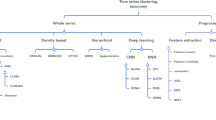Abstract
Several frequency-selection strategies have been used to obtain global minimum solutions in waveform inversion. One strategy, called the discretization method, is to discretize frequencies with a large sampling interval to minimize redundancy in wavenumber information. Another method, the grouping method, groups frequencies with redundancy in wavenumber information. The grouping method can be carried out in two ways. With the first method, the minimum frequency is fixed and the maximum frequency is gradually extended upward (i.e., the overlap-grouping method). Under the second method, frequencies are not overlapped across the groups and waveform inversion proceeds from lower to higher frequency groups (i.e., the individual-grouping method). In this study, we compare these three frequency-selection strategies using both synthetic and real data examples based on logarithmic waveform inversion. Numerical examples for synthetic and real field data demonstrate that the three frequency-selection methods provide solutions closer to the global minimum compared to solutions resulting from simultaneously performed waveform inversion, and that the individual-grouping method yields slightly better resolution for the velocity models than the other methods, particularly for the deeper part. These results may imply that using either too small or too large data sets at every stage slightly deteriorates inversion results, and that grouping data in appropriately sized aggregations improves inversion results.








Similar content being viewed by others
References
Berkhout, A.J., (1984), Multidimensional linearized inversion and seismic migration, Geophysics, 49, 1881–1895.
Boonyasiriwat, C., Valasek, P., Routh, P., Cao, W., Schuster, G. T., and Macy, B., (2009), An efficient multiscale for time-domain waveform tomography: Geophysics, 74(6), WCC59-WCC68.
Brandsberg-Dahl, S.,Ursin, B., and de Hoop, M.V., (2003), Seismic velocity analysis in the scattering-angle/azimuth domain, Geophysical Prospecting, 51, 295–314.
Bunks, C., Saleck, F.M., Zaleski, S., and Chavent, G., (1995), Multiscale seismic waveform inversion, Geophysics, 60, 1457–1473.
Devaney, A.J., (1984), Geophysical diffraction tomography, IEEE Trans. on Geoscience and Remote Sensing, GE-22, 1, 3–13.
Esmersoy, C., (1986), The backpropagated field approach to multidimensional velocity inversion, Ph.D. thesis, Massachusetts Institute of Technology.
Ha, T., Chung, W.–K., and Shin, C., (2009), Waveform inversion using a back-propagation algorithm and a Huber function: Geophysics, 74(3), R15–R24.
Kim, J.H., and Kim, S.J., (1999), A multifrontal solver combined with graph partitioners, AIAA J. 38, 964–970.
Levy, B., and Esmersoy, C., (1988), Variable background born inversion by wavefield back propagation, Siam J. Appl. Math., 48, 4, 952–972.
Marfurt, K. J., (1984), Accuracy of finite-difference and finite-element modeling of the scalar and elastic wave equations: Geophysics, 49, 533–549.
Pratt, R. G., (1999), Seismic waveform inversion in the frequency domain, Part 1:Theory and verification in a physical scale model: Geophysics, 64, 888–901.
Press, W. H., Teukolsky, S. A., Vetterling, W. T., and Flannery, B. P., (1992), Numerical recipes in Fortran: Second edition: Cambridge University Press, 395–398.
Shin, C., and Cha, Y. H., (2008), Waveform inversion in the Laplace domain: Geophys. J. Int., 173, 922–931.
Shin, C., and Min, D.-J., (2006), Waveform inversion using a logarithmic wavefield, Geophysics, 71, R31–R42.
Shin, C., Jang, S., and Min, D.-J., (2001), Improved amplitude preservation for prestack depth migration by inverse scattering theory, Geophysical Prospecting, 49, 592–606.
Shin, C., Pyun, S., and Bednar, J. B., (2007), Comparison of waveform inversion, part 1: Conventional wavefield vs logarithmic wavefield: Geophysical Prospecting, 55, 449-464.
Shipp, R. M., and Singh, S. C., (2002), Two-dimensional full wavefield inversion of wide-aperture marine seismic streamer data: Geophysical Journal International, 151, 325–344.
Sirgue, L., and Pratt, R.G., (2004), Efficient waveform inversion and imaging: A strategy for selecting temporal frequencies, Geophysics, 69, 231–248.
Song, Z. M., Williamson, P. R., and Pratt, R. G., (1995), Frequency-domain acoustic-wave modeling and inversion of crosshole data: Part II-Inversion method, synthetic experiments and real-data results: Geophysics, 60, 796–809.
Tarantola, A., (1984), Inversion of seismic reflection data in the acoustic approximation, Geophysics, 49, 1259–1266.
Versteeg, R., (1994), The Marmousi experience: Velocity model determination on a synthetic complex data set, The Leading Edge, 13, 927–936.
Wu, R.S., and Toksöz, M.N., (1987), Diffraction tomography and multisource holography applied to seismic imaging: Geophysics, 52, 11–25.
Acknowledgments
This work was financially supported by the Brain Korea 21 project of the Ministry of Education, Science and Technology (MEST), and the Energy Technology Innovation (ETI) project funded by the Ministry of Knowledge Economy.
Author information
Authors and Affiliations
Corresponding author
Rights and permissions
About this article
Cite this article
Kim, Y., Cho, H., Min, DJ. et al. Comparison of Frequency-Selection Strategies for 2D Frequency-Domain Acoustic Waveform Inversion. Pure Appl. Geophys. 168, 1715–1727 (2011). https://doi.org/10.1007/s00024-010-0196-8
Received:
Revised:
Accepted:
Published:
Issue Date:
DOI: https://doi.org/10.1007/s00024-010-0196-8




